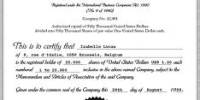The IAS 30 is to prescribe appropriate presentation and disclosure standards for banks and similar financial institutions (hereafter called ‘banks’), which supplement the requirements of other Standards. The intention is to provide users with appropriate information to assist them in evaluating the financial position and performance of banks, and to enable them to obtain a better understanding of the special characteristics of the operations of banks.
Objectives of the Term Paper:
Main object of this term paper is to know about the ‘Rules of IAS 30’ and find out how applying the IAS 30 by Phoenix Finances Ltd.
Continuous Improvement of customer satisfactions and resource management
Methodology:
All information of this term paper is collected from two sources.
These are given on the below.
First one is Primary Data (directly collected from Annual Report of The Phoenix Finances Ltd.).
And another is Secondary Data (from the Internet).
Limitations:
This report is not out of some limitations. Throughout the report we have faced a lot of problems. Some of this are-
- Limitations regarding appropriate locations
- Lack of information on recent wind speed.
- No definite government rules regarding about company Act etc.
ABOUT US
COMPANY PROFILE
Phoenix Finance & Investments Limited (Former Phoenix Leasing Company Limited), one of the leading and reliable multi products Financial Institution in Bangladesh was incorporated in Bangladesh on April 19,1995 as Public Limited Company under the Companies Act 1994 and started its operation on May 9 1995 as a Non Banking Financial Institution under Financial Institution Act 1993 , it has changed its name to Phoenix Finance & Investment Limited (PFIL) with a view to reflecting multi-dimensional financial activities the company has been doing other than Lease Financing which although , has remained as the prime area of the financial activities.
Authorized capital of the Company is TK,1000 million divided into 10,000,000 ordinary shares of TK.100 each. PFIL has floated its share through the Initial Public Offering (IPO) of the Company for 12,50,000 Ordinary Share of TK 100 each at par amounting to Tk 12.50 crore in 2007. Now the paid up capital of the Company has been raised to 43,70,437 share amounting to Tk 43,70,43,700. The shares of the Company were listed with Dhaka and Chittagong Stock Exchanges on September 25, 2007.
Sponsor shareholders of the company includes a renowned corporate body namely Phoenix Insurance Company Ltd., a leading Insurance Company in Bangladesh .Others are Individuals having wide range of experience in the field of Commerce and Industries.
The main objective of Phoenix Finance and Investments Limited is to allocate scarce financial resources to capital investment through funding in capital machinery / equipment specially BMRE of the existing industrial enterprise to stimulate the industrial development of the country and also to provide financial assistance through leasing and other multi- dimensional products & services to all levels of entrepreneurs for a wider range of asset acquisition.
The company has also diversified its products and services to such other areas as Housing and Real Estate, Bridge Financing, short term and Mid Term Loan and startup working capital to cater to divergent needs of the economy, The company also opened a SME Branch in Dhaka on February 7, 2007 for promoting Small and Medium enterprise (SME) exclusively for alleviation of poverty through creation of employment and generation of income on a sustainable basis. Besides this, PFIL also acquired 25% ownership of Brokerage Company dealing with the Dhaka and Chittagong Stock Exchange to further diversify its investment activities.
PFIL now offers a wide range of financial services tailored to the needs of its customers which includes:
| Asset Products | Debt Products |
| Lease Finance Housing & Real Estate (Including Bangladesh Bank Refinance scheme) Short Term Finance Mid Term Finance Long Term Finance Financing against confirmed work order Start-up working capital Bridge Finance Factoring SME Loan Investment in Capital Markets | Advance Income Option |
CORPORATE SERVICES
- Syndication of Loan/Lease
- Corporate Advisory
- Investment Counseling
PFIL provides brokerage services through its 25% owned Associated Company named Phoenix Securities Limited (PSL), a member of DSE & CSE.
Milestones
| April 19, 1995 | Incorporation |
| April 19, 1995 | Commencement of Business |
| May 09, 1995 | Licenced under Bangladesh Bank |
| September 21, 1995 | Signing of First Lease Agreement |
| April, 1996 | Member, Asian Leasing & Finance Association – ALFA |
| September 25, 1996 | Opening of Branch in Chittagong |
| September 21, 1997 | Web Site Launched |
| November 05, 2000 | Achieved Tk. 100 crore Finance |
| August 04, 2004 | Opening of Branch in Khulna |
| September, 2004 | Member, Association of National Development Finance Institutions in Member countries of the Islamic Development Bank – ADFIMI |
| September 19, 2005 | Opening of Branch in Bogra |
| January, 2006 | Member, Institute of Bankers, Bangladesh -IBB |
| February 01,2007 | Company changes name from PLC to PFIL |
| February 07, 2007 | Opening of SME Branch in Dhaka |
| February 12, 2007 | Acquisition of DSE Member Company |
| May 20, 2007 | Prospectus issued for IPO of PFIL |
| May 27, 2007 | Head Office shifted to Eunoos Center |
| September 25, 2007 | Listed with Dhaka & Chittagong Stock Exchanges |
| September 27,2007 | Trading of public shares of PFIL commenced |
| December, 2007 | Achieved Tk. 500 Crore Finance |
| August 28, 2008 | Opening of Uttara Branch in Dhaka |
| May 21, 2009 | Opening of Imamgonj Branch in Dhaka |
| August 10, 2010 | Opening of Dhanmondi Branch in Dhaka |
| September 5, 2010 | Awarded the International Star Award for Quality (ISAQ) in the Gold Category from Business Initiative Directions (BID) |
COMPANY VISION & MISSION
Our Vision
To act as the best financial service provider in the country.
Our Mission
. To provide multiple financial products and services . To provide entrepreneurship skills and enterprises
. To promote employment generation and poverty alleviation
. To accelerate the pace of industrialization for prosperous Bangladesh . To promote passion for posterity
. To promote SME sector .
FINANCIAL PRODUCTS & SERVICES
● Lease Finance ● SOD against Work Order
● Real Estate Finance ● Mid Term Finance
● Team Finance ● SME Finance
● Term loan against pledge of TDR ● Short Term Finance
INTRODUCTION
IAS 30 – Disclosures in the Financial Statements of Banks and Similar Financial Institutions
International Accounting Standard 30 Disclosures in the Financial Statements of Banks and Similar Financial Institutions
This version includes amendments resulting from new and amended IFRSs issued up to 31 March 2004. The section “Changes in this Edition” at the front of this volume provides the application dates of these new and amended IFRSs and also identifies those current IFRSs that are not included in this volume.
International Accounting Standard 30 Disclosures in the Financial Statements of Banks and Similar Financial Institutions (IAS 30) is set out in paragraphs 1-59. All the paragraphs have equal authority but retain the IASC format of the Standard when it was adopted by the IASB. IAS 30 should be read in the context of the Preface to International Financial Reporting Standards and the Framework for the Preparation and Presentation of Financial Statements. IAS 8 Accounting Policies, Changes in Accounting Estimates and Errors provides a basis for selecting and applying accounting policies in the absence of explicit guidance.
SCOPE of the Study:
Paragraph:1. This Standard shall be applied in the financial statements of banks and similar financial institutions (subsequently referred to as banks).
Paragraph:2. For the purposes of this Standard, the term “bank” includes all financial institutions, one of whose principal activities is to take deposits and borrow with the objective of lending and investing and which are within the scope of banking or similar legislation. The Standard is relevant to such entities whether or not they have the word “bank” in their name.
Paragraph:3. Banks represent a significant and influential sector of business worldwide. Most individuals and organizations make use of banks, either as depositors or borrowers. Banks play a major role in maintaining confidence in the monetary system through their close relationship with regulatory authorities and governments and the regulations imposed on them by those governments. Hence there is considerable and widespread interest in the well-being of banks, and in particular their solvency and liquidity and the relative degree of risk that attaches to the different types of their business. The operations, and thus the accounting and reporting requirements, of banks are different from those of other commercial entities. This Standard recognizes their special needs. It also encourages the presentation of a commentary on the financial statements which deals with such matters as the management and control of liquidity and risk.
Paragraph:4. This Standard supplements other Standards which also apply to banks unless they are specifically exempted in a Standard.
Paragraph:5. This Standard applies to the separate financial statements and the consolidated financial statements of a bank. Where a group undertakes banking operations, this Standard is applicable in respect of those operations on a consolidated basis.
BACKGROUND of the Study:
Paragraph:6. The users of the financial statements of a bank need relevant, reliable and comparable information which assists them in evaluating the financial position and performance of the bank and which is useful to them in making economic decisions. They also need information which gives them a better understanding of the special characteristics of the operations of a bank. Users need such information even though a bank is subject to supervision and provides the regulatory authorities with information that is not always available to the public. Therefore disclosures in the financial statements of a bank need to be sufficiently comprehensive to meet the needs of users, within the constraint of what it is reasonable to require of management.
Paragraph:7. The users of the financial statements of a bank are interested in its liquidity and solvency and the risks related to the assets and liabilities recognized on its balance sheet and to its off balance sheet items. Liquidity refers to the availability of sufficient funds to meet deposit withdrawals and other financial commitments as they fall due. Solvency refers to the excess of assets over liabilities and, hence, to the adequacy of the bank’s capital. A bank is exposed to liquidity risk and to risks arising from currency fluctuations, interest rate movements, and changes in market prices and from counterparty failure. These risks may be reflected in the financial statements, but users obtain a better understanding if management provides a commentary on the financial statements which describes the way it manages and controls the risks associated with the operations of the bank.
Accounting Policies
Paragraph:8. Banks use differing methods for the recognition and measurement of items in their financial statements. While harmonization of these methods is desirable, it is beyond the scope of this Standard. In order to comply with IAS 1 Presentation of Financial Statements and thereby enable users to understand the basis on which the financial statements of a bank are prepared, accounting policies dealing with the following items may need to be disclosed:
(a) The recognition of the principal types of income (see paragraphs 10 and 11);
(b) The valuation of investment and dealing securities (see paragraphs 24 and 25);
(c) The distinction between those transactions and other events that result in the recognition of assets and liabilities on the balance sheet and those transactions and other events that only give rise to contingencies and commitments (see paragraphs 26-29);
(d) The basis for the determination of impairment losses on loans and advances and for writing off uncollectible loans and advances (see paragraphs 43-49); and
(e) The basis for the determination of charges for general banking risks and the accounting treatment of such charges (see paragraphs 50-52).
Some of these topics are the subject of existing Standards while others may be dealt with at a later date.
INCOME STATEMENT
Paragraph:9. A bank shall present an income statement which groups income and expenses by nature and discloses the amounts of the principal types of income and expenses.
Recommendation: The Phoenix Finance shall present an income statement which groups income and expenses by nature and discloses the amounts of the principal types of income and expenses.
Paragraph:10. In addition to the requirements of other Standards, the disclosures in the income statement or the notes shall include, but are not limited to, the following items of income and expenses:
Ø Interest and similar income;
Ø Interest expense and similar charges;
Ø Dividend income;
Ø Fee and commission income;
Ø Fee and commission expense;
Ø Gains less losses arising from dealing securities;
Ø Gains less losses arising from investment securities;
Ø Gains less losses arising from dealing in foreign currencies;
Ø Other operating income & expense;
Ø Impairment losses on loans and advances;
Ø General administrative expenses; and
Recommendation: The Phoenix Finance addition to the requirements of other Standards, the disclosures in the income statement or the notes shall include, but are not limited to, the following items of income and expenses.
Paragraph:11. The principal types of income arising from the operations of a bank include interest, fees for services, commissions and dealing results. Each type of income is separately disclosed in order that users can assess the performance of a bank. Such disclosures are in addition to those of the source of income required by IAS 14 Segment Reporting.
Recommendation: The Phoenix Finance mansion The principal types of income arising from the operations of a bank include interest, fees for services, commissions and dealing results. Each type of income is separately disclosed in order that users can assess the performance of a bank.
Paragraph:12. The principal types of expenses arising from the operations of a bank include interest, commissions, losses on loans and advances, charges relating to the reduction in the carrying amount of investments and general administrative expenses. Each type of expense is separately disclosed in order that users can assess the performance of a bank.
Recommendation: The Phoenix Finance mansion interest, commissions, losses on loans and advances, charges relating to the reduction in the carrying amount of investments and general administrative expenses. Each type of expense is separately disclosed in order that users can assess the performance of a bank.
Paragraph:13. Income and expense items shall not be offset except for those relating to hedges and to assets and liabilities that have been offset in accordance with IAS 32.
Recommendation: The Phoenix Finance present their Income and expense items shall not be offset except for those relating to hedges and to assets and liabilities.
Paragraph:14. Offsetting in cases other than those relating to hedges and to assets and liabilities that have been offset as described in IAS 32 prevents users from assessing the performance of the separate activities of a bank and the return that it obtains on particular classes of assets.
Recommendation: The Phoenix Finance mansion offsetting in cases other than those relating to hedges and to assets and liabilities that have been offset as described & the performance of the separate activities of a bank/nonbanking financial institutions and the return that it obtains on particular classes of assets. (Page- 1/78)
Paragraph:15. Gains and losses arising from each of the following are normally reported on a net basis:
(a) Disposals and changes in the carrying amount of dealing securities;
(b) Disposals of investment securities; and
(c) Dealings in foreign currencies.
Recommendation: The Phoenix Finance present gains and losses arising from each are normally reported on a net basis.
Paragraph:16. Interest income and interest expense are disclosed separately in order to give a better understanding of the composition of, and reasons for changes in, net interest.
Recommendation: The Phoenix Finance present Interest income and interest expense are disclosed separately in order to give a better understanding of the composition. (Page- 1/78)
Paragraph:17. Net interest is a product of both interest rates and the amounts of borrowing and lending. It is desirable for management to provide a commentary about average interest rates, average interest earning assets and average interest-bearing liabilities for the period. In some countries, governments provide assistance to banks by making deposits and other credit facilities available at interest rates which are substantially below market rates. In these cases, management’s commentary often discloses the extent of these deposits and facilities and their effect on net income.
Recommendation: The Phoenix Finance does not present interest rates and the amounts of borrowing and lending as per their business strategy.
BALANCE SHEET
Paragraph:18. A bank shall present a balance sheet that groups assets and liabilities by nature and lists them in an order that reflects their relative liquidity.
Recommendation: The Phoenix Finance presents a balance sheet that groups assets and liabilities by nature and lists them in an order that reflects their relative liquidity.
Paragraph:19. In addition to the requirements of other Standards, the disclosures in the balance sheet or the notes shall include, but are not limited to, the following assets and liabilities.
Assets
Ø Cash and balances with the central bank;
Ø Treasury bills and other bills eligible for rediscounting with the central bank;
Ø Government and other securities held for dealing purposes;
Ø Placements with, and loans and advances to, other banks;
Ø Other money market placements;
Ø Loans and advances to customers; and
Ø Investment securities.
Liabilities
Ø Deposits from other banks;
Ø Other money market deposits;
Ø Amounts owed to other depositors;
Ø Certificates of deposits;
Ø Promissory notes and other liabilities evidenced by paper; and
Ø Other borrowed funds.
Recommendation: The Phoenix Finance presents addition to the requirements of other Standards, the disclosures in the balance sheet or the notes shall include, but are not limited to, the following assets and liabilities.
Paragraph:20. The most useful approach to the classification of the assets and liabilities of a bank is to group them by their nature and list them in the approximate order of their liquidity; this may equate broadly to their maturities. Current and non-current items are not presented separately because most assets and liabilities of a bank can be realized or settled in the near future.
Recommendation: The Phoenix Finance presents the classification of the assets and liabilities of a bank/non-banking financial institutions are to group them by their nature and list them in the approximate order of their liquidity; this may equate broadly to their maturities. Current and non-current items are not presented separately because most assets and liabilities of a bank can be realized or settled in the near future.
Paragraph:21. The distinction between balances with other banks and those with other parts of the money market and from other depositors is relevant information because it gives an understanding of a bank’s relations with, and dependence on, other banks and the money market. Hence, a bank discloses separately:
(a) Balances with the central bank;
(b) Placements with other banks;
(c) Other money market placements;
(d) Deposits from other banks;
(e) Other money market deposits; and
(f) Other deposits.
Recommendation The Phoenix Finance presents the distinction between balances with other banks and those with other parts of the money market and from other depositors is relevant information. (Page-2/76)
Paragraph:22. A bank generally does not know the holders of its certificates of deposit because they are usually traded on an open market. Hence, a bank discloses separately deposits that have been obtained through the issue of its own certificates of deposit or other negotiable paper.
Recommendation: The Phoenix Finance discloses separately deposits that have been obtained through the issue of its own certificates of deposit or other negotiable paper.
Paragraph:23. [Deleted]
Paragraph:24. A bank shall disclose the fair values of each class of its financial assets and liabilities as required by IAS 32 Financial Instruments: Disclosure and Presentation.
Recommendation: The Phoenix Finance disclose the fair values of each class of its financial assets and liabilities
Paragraph:25. IAS 39 provides for four classifications of financial assets: loans and receivables, held-to-maturity investments, financial assets at fair value through profit or loss, and available-for-sale financial assets. A bank shall disclose the fair values of its financial assets for these four classifications, as a minimum.
Recommendation: The Phoenix Finance discloses the fair values of its financial assets for these four classifications, as a minimum.
Ω CONTINGENCIES & COMMITMENTS INCLUDING OFF BALANCE SHEET ITEMS
Paragraph:26. A bank shall disclose the following contingent liabilities and commitments:
(a) the nature and amount of commitments to extend credit that are irrevocable because they cannot be withdrawn at the discretion of the bank without the risk of incurring significant penalty or expense; and
(b) the nature and amount of contingent liabilities and commitments arising from off balance sheet items including those relating to:
(i) direct credit substitutes including general guarantees of indebtedness, bank acceptance guarantees and standby letters of credit serving as financial guarantees for loans and securities;
(ii) certain transaction-related contingent liabilities including performance bonds, bid bonds, warranties and standby letters of credit related to particular transactions;
(iii) Short-term self-liquidating trade-related contingent liabilities arising from the movement of goods, such as documentary credits where the underlying shipment is used as security; and
(iv) [Deleted]
(v) [Deleted]
(vi) other commitments, note issuance facilities and revolving underwriting facilities.
Recommendation: The Phoenix Finance discloses the contingent liabilities and commitments.
Paragraph:27. IAS 37 Provisions, Contingent Liabilities and Contingent Assets deals generally with accounting for, and disclosure of, contingent liabilities. The Standard is of particular relevance to banks because banks often become engaged in many types of contingent liabilities and commitments, some revocable and others irrevocable, which are frequently significant in amount and substantially larger than those of other commercial entities.
Recommendation: The Phoenix Finance contingent Liabilities and Contingent Assets deals generally with accounting for, and disclosure of, contingent liabilities. The Standard is of particular relevance to banks.
Paragraph:28. Many banks also enter into transactions that are presently not recognised as assets or liabilities in the balance sheet but which give rise to contingencies and commitments. Such off balance sheet items often represent an important part of the business of a bank and may have a significant bearing on the level of risk to which the bank is exposed. These items may add to, or reduce, other risks, for example by hedging assets or liabilities on the balance sheet.
Recommendation: The Phoenix Finance mansion transactions that are presently not recognised as assets or liabilities in the balance sheet.
Paragraph:29. The users of the financial statements need to know about the contingencies and irrevocable commitments of a bank because of the demands they may put on its liquidity and solvency and the inherent possibility of potential losses. Users also require adequate information about the nature and amount of off balance sheet transactions undertaken by a bank.
Recommendation: The Phoenix Finance present the financial statements need to know about the contingencies and irrevocable commitments of a bank.
MATURITIES OF ASSETS & LIABILITIES
Paragraph:30. A bank shall disclose an analysis of assets and liabilities into relevant maturity groupings based on the remaining period at the balance sheet date to the contractual maturity date.
Recommendation: The Phoenix Finance does not disclose an analysis of assets and liabilities into relevant maturity groupings based on the remaining period at the balance sheet date to the contractual maturity date.
Paragraph:31. The matching and controlled mismatching of the maturities and interest rates of assets and liabilities is fundamental to the management of a bank. It is unusual for banks ever to be completely matched since business transacted is often of uncertain term and of different types. An unmatched position potentially enhances profitability but can also increase the risk of losses.
Paragraph:32. The maturities of assets and liabilities and the ability to replace, at an acceptable cost, interest-bearing liabilities as they mature, are important factors in assessing the liquidity of a bank and its exposure to changes in interest rates and exchange rates. In order to provide information that is relevant for the assessment of its liquidity, a bank discloses, as a minimum, an analysis of assets and liabilities into relevant maturity groupings.
Paragraph:33. The maturity groupings applied to individual assets and liabilities differ between banks and in their appropriateness to particular assets and liabilities. Examples of periods used include the following:
(a) Up to 1 month;
(b) From 1 month to 3 months;
(c) From 3 months to 1 year;
(d) From 1 year to 5 years; and
(e) From 5 years and over.
Frequently the periods are combined, for example, in the case of loans and advances, by grouping those under one year and those over one year. When repayment is spread over a period of time, each installment is allocated to the period in which it is contractually agreed or expected to be paid or received.
Recommendation: The Phoenix Finance discloses the maturity groupings applied to individual assets and liabilities differ between banks and in their appropriateness to particular assets and liabilities.
Paragraph:34. It is essential that the maturity periods adopted by a bank are the same for assets and liabilities. This makes clear the extent to which the maturities are matched and the consequent dependence of the bank on other sources of liquidity.
Recommendation: The Phoenix Finance clear the extent to which the maturities are matched and the consequent dependence of the bank on other sources of liquidity.
Paragraph:35. Maturities could be expressed in terms of:
(a) The remaining period to the repayment date;
(b) The original period to the repayment date; or
(a) The remaining period to the next date at which interest rates may be changed.
The analysis of assets and liabilities by their remaining periods to the repayment dates provides the best basis to evaluate the liquidity of a bank. A bank may also disclose repayment maturities based on the original period to the repayment date in order to provide information about its funding and business strategy. In addition, a bank may disclose maturity groupings based on the remaining period to the next date at which interest rates may be changed in order to demonstrate its exposure to interest rate risks. Management may also provide, in its commentary on the financial statements, information about interest rate exposure and about the way it manages and controls such exposures.
Recommendation: The Phoenix Finance doesn’t disclose repayment maturities based on the original period to the repayment date in order to provide information about its funding and business strategy.
Paragraph:36. In many countries, deposits made with a bank may be withdrawn on demand and advances given by a bank may be repayable on demand. However, in practice, these deposits and advances are often maintained for long periods without withdrawal or repayment; hence, the effective date of repayment is later than the contractual date. Nevertheless, a bank discloses an analysis expressed in terms of contractual maturities even though the contractual repayment period is often not the effective period because contractual dates reflect the liquidity risks attaching to the bank’s assets and liabilities.
Recommendation: The Phoenix Finance doesn’t disclose contractual dates reflect the liquidity risks attaching to the bank’s assets and liabilities. (Page-4/ 93)
Paragraph:37. Some assets of a bank do not have a contractual maturity date. The period in which these assets are assumed to mature is usually taken as the expected date on which the assets will be realized.
Paragraph:38. The users’ evaluation of the liquidity of a bank from its disclosure of maturity groupings is made in the context of local banking practices, including the availability of funds to banks. In some countries, short-term funds are available, in the normal course of business, from the money market or, in an emergency, from the central bank. In other countries, this is not the case.
Recommendation: The Phoenix Finance disclose the liquidity of a bank/non-banking financial institutions from its disclosure of maturity groupings is made in the context of local banking practices, including the availability of funds to banks.
Paragraph:39. In order to provide users with a full understanding of the maturity groupings, the disclosures in the financial statements may need to be supplemented by information as to the likelihood of repayment within the remaining period. Hence, management may provide, in its commentary on the financial statements, information about the effective periods and about the way it manages and controls the risks and exposures associated with different maturity and interest rate profiles.
Recommendation: The Phoenix Finance doesn’t disclose repayment within the remaining period.
C0NCENTRATIONS OF ASSETS, LIABILITIES & OFF BALANCE SHEET ITEMS
Paragraph:40. A bank shall disclose any significant concentrations of its assets, liabilities and off balance sheet items. Such disclosures shall be made in terms of geographical areas, customer or industry groups or other concentrations of risk. A bank shall also disclose the amount of significant net foreign currency exposures.
Recommendation: The Phoenix Finance discloses the amount of significant net foreign currency exposures.
Paragraph:41. A bank discloses significant concentrations in the distribution of its assets and in the source of its liabilities because it is a useful indication of the potential risks inherent in the realization of the assets and the funds available to the bank. Such disclosures are made in terms of geographical areas, customer or industry groups or other concentrations of risk which are appropriate in the circumstances of the bank. A similar analysis and explanation of off balance sheet items is also important. Geographical areas may comprise individual countries, groups of countries or regions within a country; customer disclosures may deal with sectors such as governments, public authorities, and commercial and business entities. Such disclosures are made in addition to any segment information required by IAS 14 Segment Reporting.
Paragraph:42. The disclosure of significant net foreign currency exposures is also a useful indication of the risk of losses arising from changes in exchange rates.
Recommendation: The Phoenix Finance doesn’t disclosure of significant net foreign currency exposures is also a useful indication of the risk of losses arising from changes in exchange rates.
Bibliography
Phoenix Finance Annual Report – 2008
International Accounting Standard Rules 30 (IAS – 30)
Bangladesh Accounting Standard
















